Evolution exam 1 stuvia - Study guides, Class notes & Summaries
Looking for the best study guides, study notes and summaries about Evolution exam 1 stuvia? On this page you'll find 40 study documents about Evolution exam 1 stuvia.
Page 4 out of 40 results
Sort by
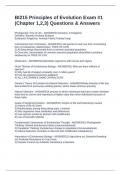
-
BI215 Principles of Evolution Exam #1 (Chapter 1,2,3) Questions & Answers
- Exam (elaborations) • 4 pages • 2024
-
- $13.49
- + learn more
Phylogenetic Tree of Life - ANSWERS3 Domains, 6 Kingdoms Domains: Bacteria Archaea Eukarya Eukaryotic Kingdoms: Animals Plants Protista Fungi Conclusions from 3 Domains - ANSWERS1) All species to ever live form a branching tree of evolutionary relationships ( TREE OF LIFE) 2) All living things descended from a common ancestral population 3) Over time, descendants of common ancestral population diversified to produce biodiversity on TREE OF LIFE Metazoans - ANSWERSmulticellular organism...
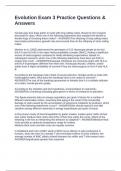
-
Evolution Exam 3 Practice Questions & Answers
- Exam (elaborations) • 5 pages • 2024
-
- $13.49
- + learn more
Female gray tree frogs prefer to mate with long-calling males. Based on the research discussed in class, which one of the following statements best explains the benefit to female frogs of choosing these males? - ANSWERSThe offspring of long-calling males have better performance (growth rate and survival) than do the offspring of short-calling males. Markow et al. (1993) determined the genotypes of 122 Havasupai people at two loci (HLA-A and HLA-B) in the major histocompatibility complex (MHC)...

-
Quizzes for Evolution Exam #1 Questions & Answers
- Exam (elaborations) • 3 pages • 2024
-
- $13.49
- + learn more
1. Several independent species evolve a new body shape from a mutation in the same gene. This is an example of: a. Parallel evolution b. Parsimony c. Mosaic evolution d. Vicariance - ANSWERSa 2. Why was DNA an unlikely candidate for the first information bearing molecule in living systems? a. DNA is unable to catalyze reactions b. DNA cannot store and transmit genetic information c. Nucleic acids like DNA cannot be synthesized by abiotic reactions d. Most living systems do not transmi...

-
Paciulli FINAL BIO 181 NCSU Exam Study Guide Solutions
- Exam (elaborations) • 31 pages • 2024
-
- $12.49
- + learn more
Paciulli FINAL BIO 181 NCSU Exam Study Guide Solutions To the west of Wallace's Line in Southeast Asia are organisms related to Asiatic species. To the east of the line, there is a mixture of species of Asian and Australian origin. This is an example of: - ANSWER- biogeography Two members of the initial Amish migration to Pennsylvania in 1744 shared the recessive allele for Ellis- van Creveld syndrome, which results in a long narrow chest and shortening of the limbs. More Amish people ...
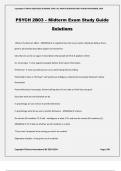
-
PSYCH 2B03 – Midterm Exam Study Guide Solutions
- Exam (elaborations) • 90 pages • 2024
-
- $13.49
- + learn more
PSYCH 2B03 – Midterm Exam Study Guide Solutions What is the Barnum effect - ANSWER-A cognitive bias that occurs when individuals believe that a generic personality description applies to themselves Idea that we can be so vague in descriptions that people all think it applies to them Ex. horoscopes → very vague but people believe them about themselves P.T Barnum → came up with barnum circus while doing fortune telling Pretended to have a "third eye" and would use ambiguous stat...

-
BIOL 205 Midterm 1 Exam Questions and Answers 100% Pass
- Exam (elaborations) • 15 pages • 2024
-
- $12.49
- + learn more
BIOL 205 Midterm 1 Exam Questions and Answers 100% Pass How did Ernst Mayr summarize Darwin's basic ideas? - ANSWER-Mayr proposed that Darwin's theory of natural selection could explain all of evolution, including why genes evolve at the molecular level. On the stubborn question of how species originate, Mayr proposed that when a population of organisms becomes separated from the main group by time or geography, they eventually evolve different traits and can no longer interbreed. Ma...

-
UBCO BIOL 201 Evolution and Ecology Exam Questions and Answers
- Exam (elaborations) • 10 pages • 2024
-
- $12.49
- + learn more
UBCO BIOL 201 Evolution and Ecology Exam Questions and Answers Type 1 Survivorship Curve - ANSWER-High survivorship in young, physiological survivorship, usually seen when no external death factors, Ex. humans, elephants Type 2 Survivorship Curve - ANSWER-Constant linear decline survivorship, constant mortality throughout lifetime, Ex. squirrels Type 3 Survivorship Curve - ANSWER-High mortality in young, adults produce large amounts of offspring in order to combat the high youth mortality...
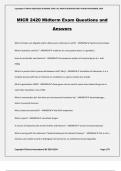
-
MICR 2420 Midterm Exam Questions and Answers
- Exam (elaborations) • 75 pages • 2024
-
- $12.49
- + learn more
MICR 2420 Midterm Exam Questions and Answers What microbes can degrade and/or utilize every molecule on earth? - ANSWER-bacteria and archaea What is botulism used for? - ANSWER-medicine (is a very potent toxin; is a paralytic) How do we identify new bacteria? - ANSWER-by sequence analysis of universal genes (i.e. with rRNA) What is a process that is preserved between cells? Why? - ANSWER-translation of ribosomes; it is a complex process with lots of restraints on mutations (i.e. genes mut...
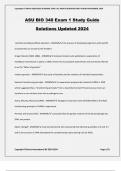
-
ASU BIO 340 Exam 1 Study Guide Solutions Updated 2024
- Exam (elaborations) • 21 pages • 2024
-
- $12.49
- + learn more
ASU BIO 340 Exam 1 Study Guide Solutions Updated 2024 selective breeding (artificial selection) - ANSWER-the process of developing organisms with specific characteristics as chosen by the breeders Gregor Mendel () - ANSWER-Amateur botanist who published an explanation of hereditary transmission in plants in 1866. Known for his pea-plant experiments and commonly referred to as the "father of genetics" modern genetics - ANSWER-the study of heredity and the variation of inherited chara...
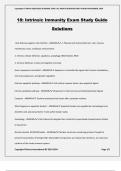
-
18: Intrinsic Immunity Exam Study Guide Solutions
- Exam (elaborations) • 5 pages • 2024
-
- $11.49
- + learn more
18: Intrinsic Immunity Exam Study Guide Solutions Host defenses against viral infection - ANSWER-1. Physical and chemical barriers: skin, mucous membranes, tears, acid/basic environments 2. Intrinsic cellular defenses: apoptosis, autophagy, ND10 bodies, RNAi 3. Immune defenses: innate and adaptive immunity How is apoptosis controlled? - ANSWER-Apoptosis is controlled by signals that monitor metabolism, cell cycle progression, and growth regulation Extrinsic apoptotic pathway - ANSWER-Cel...

How did he do that? By selling his study resources on Stuvia. Try it yourself! Discover all about earning on Stuvia


